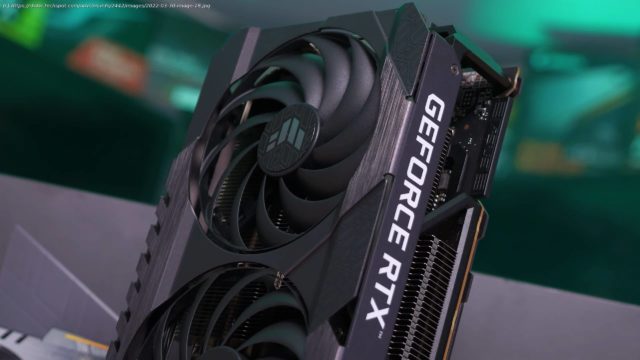The RTX 3090 Ti is an overclocked 3090 with a ludicrously high power rating of 450 watts, a ~30% increase over the original. Is that dumb? Surely…
Nvidia launched the first RTX Ampere GPUs about 18 months ago, including the flagship GeForce RTX 3090, a $1,500 graphics card that we said was a boring and rather pointless release in our day-one review. At least to gamers, the RTX 3090 made little sense since there was no need to have a massive 24GB VRAM buffer, and despite Nvidia’s best efforts,8K gaming just isn’t a thing. Unfortunately though, « boring and rather pointless » would be a good way to summarize the entire graphics card segment over the past year and a half, and you can probably include the word « hopeless » in there as well. Since release and for months on end, even pointless products like the RTX 3090 were nearly impossible to find, unless you were willing to pay scalper prices of ~$3,000 for the fastest GPUs on the market. Thankfully, pricing has started to drop, though in most cases it’s still inflated. You can now get an RTX 3090 starting at $1,900, which is still 30% over MSRP, but well down on the $3,000+ prices we were faced with not that long ago. The original RTX 3080 is currently selling for $1,100 though, meaning you’re paying over 70% more for a 3090, for what amounts to 10-15% more performance at 4K. You may want to argue that the RTX 3090 isn’t « pointless » considering it’s the most affordable graphics card with a 24GB VRAM buffer. Again, that’s worthless to gamers, but for certain production workloads, the big memory buffer could be a godsend, so there’s that. But what about a GeForce RTX 3090 Ti? Would a Ti version packing 2.5% more cores clocked 10% higher with 8% more memory bandwidth be useful to anyone? I guess that depends on the price. But, of course, it’s not replacing the original version at $1,500. This isn’t a refresh where you get a small boost at the same price point before the next generation arrives, rather this is what we’d call a « milking. » A small performance bump for a big price hike, a hike that sees the MSRP hit $2,000. Apart from a few extra cores, the 3090 Ti is just an overclocked 3090 with a ludicrously high power rating of 450 watts, nearly a 30% increase over the original 3090. Is that dumb? Surely sounds like it, but to be sure let’s first take a look at the three RTX 3090 Ti boards we have on hand and then on to the benchmarks. Starting with the Asus TUF Gaming OC, the RTX 3090 version was already very large, but the 3090 Ti is even bigger, weighing 1677 grams which isn’t that crazy, but the dimensions are quite something measuring 325mm long,150mm tall, and a whopping 63mm wide making this a 3-slot graphics card. Externally, it looks like any other 30-series TUF Gaming graphics card. There are three 100mm fans wrapped in an aluminium shroud and on the backside you get a full size aluminium backplate. The stainless steel I/O bracket features three DisplayPort outputs and two HDMI outputs. Getting down to the PCB we find a PCIe 5.0 16-pin power connector and since no power supplies support this connector (at least none you can buy right now), the 3090 Ti cards come with an adapter that feeds three 8-pin PCIe cables into the PCIe 5.0 16-pin power connector. This is basically the same 12-pin connector featured on the Nvidia Founders Edition models, just with four extra ‘sense’ pins. The biggest upgrade for all 3090 Ti graphics cards is arguably the memory. Capacity has not changed from the original, so it’s still 24GB, but memory density and frequency has improved, upgrading the memory modules capacity from 1GB to 2GB, meaning there are just 12 modules and they’re all on the front side of the PCB. This will significantly improve memory cooling performance. That also means the backplate is just extracting heat from the rear PCB, and not a dozen GDDR6X chips. Asus has still included plenty of thermal pads on the backplate though, using it as a heat spreader. The heatsink is massive as you’d expect and Asus has gone with a nickel plated copper base for extracting heat from the GPU and some of GDDR6X memory, which is a bit of an odd choice for the memory. Instead most of the memory chips are connected to an aluminum plate which won’t be as efficient at extracting heat. Overall a very good looking card with an excellent mounting method for connecting with the PCB. When put to the test, installed inside the Corsair Obsidian 500D in a 21C room, the TUF Gaming peaked at 79C for the hot spot with a peak memory temperature of 78C. The fans spun at 2400 RPM and the cores typically clocked at 1.99 GHz out of the box. We also tested the MSI RTX 3090 Ti Suprim X and this thing is a beast. It’s without question the biggest graphics card we’ve ever come across taking up 4 slots with a weight of 2145 grams. It measures 305mm long and stands 140mm tall, but at 71mm wide, it takes up 4 slots which is complete madness.






